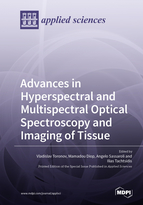Advances in Hyperspectral and Multispectral Optical Spectroscopy and Imaging of Tissue
A special issue of Applied Sciences (ISSN 2076-3417). This special issue belongs to the section "Optics and Lasers".
Deadline for manuscript submissions: closed (10 August 2021) | Viewed by 14957
Special Issue Editors
2. Institute of Biomedical Engineering, Science and Technology (iBEST), Li Ka-Shing Knowledge Institute, Toronto, ON M5B 1T8, Canada
Interests: physics of biomedical imaging (diffuse tomography, photoacoustics, NIRS, MRI); biophotonics; brain imaging
Special Issues, Collections and Topics in MDPI journals
Interests: developing noninvasive optical technologies; time-resolved near-infrared spectroscopy; diffuse correlation spectroscopy; hyperspectral continuous-wave spectroscopy; 4D hyperspectral tomographic techniques; functional tissue imaging; multichannel derivative-spectroscopy
Interests: biological imaging tissues with near-infrared spectroscopy and diffuse tomography; biomedical diagnosis; brain and breast imaging; developing new analytical and statistical models for analyzing photon migrations in biological tissues
Interests: next generation of optical non-invasive systems; functional near-infrared spectroscopy (fNIRS); optically measured biomarkers; non-invasive measurement; brain near-infrared spectroscopy (NIRS); neuroscience; bomedical imaging
Special Issue Information
Dear Colleagues,
Optical imaging and characterization of tissue has become a huge applied field due to the advantages of the optical analysis methods, which include non-invasiveness, portability, high sensitivity, and high spectral specificity. This research field continues to grow and spread in many different directions due to the development of new light sources and detectors, such as, for example, the supercontinuum and tunable lasers, portable highly sensitive spectrometers, multiwavelength photoacoustic imagers, due to novel methods of data analysis, such as the machine-learning methods of spectral analysis, and due to novel applications, such as the imaging of embryogenesis or monitoring of the cerebral oxygen metabolism.
The purpose of this Special Issue is to provide an overview of recent advances in the methods of tissue imaging and characterization which benefit from using large numbers of optical wavelengths. Potential topics include but are not limited to novel methods and instrument designs, in vivo imaging and monitoring of the human and animal organs and embryos, biomedical optical guidance, detection and characterization of diseases, and molecular imaging.
Prof. Dr. Vladislav Toronov
Prof. Dr. Mamadou Diop
Prof. Dr. Angelo Sassaroli
Prof. Dr. Ilias Tachtsidis
Guest Editors
Manuscript Submission Information
Manuscripts should be submitted online at www.mdpi.com by registering and logging in to this website. Once you are registered, click here to go to the submission form. Manuscripts can be submitted until the deadline. All submissions that pass pre-check are peer-reviewed. Accepted papers will be published continuously in the journal (as soon as accepted) and will be listed together on the special issue website. Research articles, review articles as well as short communications are invited. For planned papers, a title and short abstract (about 100 words) can be sent to the Editorial Office for announcement on this website.
Submitted manuscripts should not have been published previously, nor be under consideration for publication elsewhere (except conference proceedings papers). All manuscripts are thoroughly refereed through a single-blind peer-review process. A guide for authors and other relevant information for submission of manuscripts is available on the Instructions for Authors page. Applied Sciences is an international peer-reviewed open access semimonthly journal published by MDPI.
Please visit the Instructions for Authors page before submitting a manuscript. The Article Processing Charge (APC) for publication in this open access journal is 2400 CHF (Swiss Francs). Submitted papers should be well formatted and use good English. Authors may use MDPI's English editing service prior to publication or during author revisions.
Keywords
- Hyperspectral imaging
- Near infrared spectroscopy
- Biological tissue
- Brain imaging
- Oxygen metabolism
- Oxygen saturation
- Supercontinuum laser
- Diffuse reflectance spectroscopy
- Broadband optical spectroscopy of tissue
- Multispectral tissue imaging
- Diffuse optical tomography
- Photoacoustic imaging
- Molecular imaging
- Fluorescence imaging







